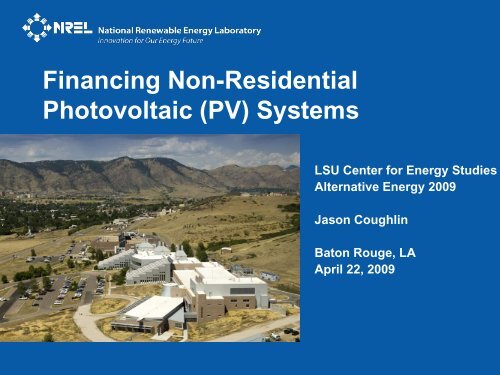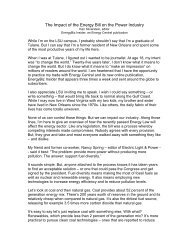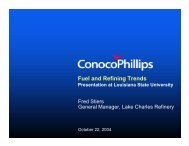Non-Residential Photovoltaics - LSU Center for Energy Studies
Non-Residential Photovoltaics - LSU Center for Energy Studies
Non-Residential Photovoltaics - LSU Center for Energy Studies
You also want an ePaper? Increase the reach of your titles
YUMPU automatically turns print PDFs into web optimized ePapers that Google loves.
Financing <strong>Non</strong>-<strong>Residential</strong>Photovoltaic (PV) Systems<strong>LSU</strong> <strong>Center</strong> <strong>for</strong> <strong>Energy</strong> <strong>Studies</strong>Alternative <strong>Energy</strong> 2009Jason CoughlinBaton Rouge, LAApril 22, 2009
NREL Overview• Located in Golden, Colorado• Began in 1977 as the Solar <strong>Energy</strong> Research Institute (SERI)• Designated a National Lab in 1991 and changed name to NREL• Federally-funded – managed by the Alliance <strong>for</strong> Sustainable<strong>Energy</strong>, LLC (Battelle and Midwest Research Institute)• Areas of expertise• Renewable electricity• Renewable fuels• Integrated energy system engineering and testing• Strategic energy analysis• Technology Transfer• > 1,200 employees2
3The Basic Elements of PV FinanceCost of a PVSystemRetail ElectricitySavings & NetMeteringAvailableIncentivesFinancing
The Cost of a PV System(per Watt be<strong>for</strong>e incentives)4$12.00$10.00$8.00$6.00$10.50$4.00$7.60$2.00$0.001998 2007Costs have declined but still expensive50 kW commercial system = $380,000Source: Tracking the Sun: The installed costs of photovoltaics in the US from 1997-2008Lawrence Berkeley National Laboratory. February 2009.http://eetd.lbl.gov/ea/emp/reports/lbnl-1516e-ppt.pdf
5The Cost of a PV SystemSource: Tracking the Sun: The installed costs of photovoltaics in the US from 1997-2008Lawrence Berkeley National Laboratory. February 2009.http://eetd.lbl.gov/ea/emp/reports/lbnl-1516e-ppt.pdf
6The Cost of a PV System (cents per kWh)Traditional electricity pricesCost of PV (kWh)Today18 – 30 cents per kwh12109.648.72864LousianaUS20<strong>Residential</strong> Commercial Industrial AverageFuture11-18¢/kWh by 20105-10 ¢/kWh by 2015“grid parity”Source: U.S. Department of <strong>Energy</strong>, EIA.Table 5.6.A. Average Retail Price of Electricity to Ultimate Customers by End-Use Sector, by State, December 2008 and 2007http://tonto.eia.doe.gov/state/state_energy_profiles.cfm?sid=LA
7Grid ParityPV18-30 cents /kWhTraditionalelectricity9.64cents/kWh
8Elements of a PV ProjectRECsRenewablePortfolioStandardsTax CreditsandExemptionsCost ofElectricityRebatesandIncentivesEconomicsof a PVSystemNetMeteringSolarResourcesFinancing
RenewablePortfolioStandardsRenewable Portfolio StandardsNY: 24% by 2013CA 20% by 201028+ states have an RPS.5 states have an RE goal.Solar hot water eligibleState RPSState GoalTX 5,880 MW by 2015DSIRE: www.dsireusa.org March 20099
10RenewablePortfolioStandardsSolar and other Distributed Generation provisionsCO: 4% of RPS from solar(RPS is 20% by 2020)NJ: 2.12% solar electric by 2021Solar hot water eligibleState RPS with solar/DG provisionState renewable goal with solar/DG provisionTX: 500 MW from non-windDSIRE: www.dsireusa.org March 2009
RECsRenewable <strong>Energy</strong> CertificatesWhat is a REC?Renewable<strong>Energy</strong>GenerationRenewable <strong>Energy</strong> AttributesCommodity Electricity• 1 REC = 1 MWh of renewable electricity• Commonly used <strong>for</strong> RPS compliance• Solar RECs are critical to getting projects financed in certain markets• $115/MWh in Colorado (10-110 kW systems)– $12,500/year <strong>for</strong> 75 kW system (estimate)• $250-300/MWh in New Jersey• Value often derived from penalty payments (Alternative Compliance Payment)11
12RebatesandIncentivesState and Utility IncentivesD.C.FL: $4/WattU.S. Virgin IslandsBoth state & utility/other programs availableState programs availableUtility/other programs availableDSIRE: www.dsireusa.org December 2008
13Tax CreditsandExemptionsState Tax CreditsDCPersonal tax credit(s) onlyCorporate tax credit(s) onlyPersonal + corporate tax credit(s)Louisiana State Tax Credit <strong>for</strong> PV (generous but limited)www.dsireusa.org / April 2009
14Tax CreditsandExemptionsFederal Tax IncentivesFederal Tax incentives‣ 30% Investment Tax Credit (ITC)• Final cost of system = $20,000• Federal tax credit = $6,000‣ Accelerated Depreciation (5yr MACRS)‣ Bonus depreciationITC + MACRS = 50+% of installed costStimulus Bill: 30% grant instead of tax creditSource: Database of State Incentives <strong>for</strong> Renewables and Efficiency (dsireusa.org)
15SolarResourcesSolar Resource#7#6#1#4#3#2#9 (CN)#8#10#5Top ten ranking <strong>for</strong> installed capacity as of 2008.Reference on following slide
Leading States <strong>for</strong> Solar (MW per year)2006 2007 2008StateCali<strong>for</strong>nia 71 87 178.6New Jersey 18 17 22.5Colorado .9 12 21.6Nevada 2.6 15 13.9Hawaii n/a 2.4 11.3New York 2.7 4.4 7.0Oregon .5 1.1 6.6Arizona 2.1 2.1 6.4Connecticut .5 1.8 5.3North Carolina n/a n/a 4.0Others 1.5 4.4 15.3Total 102 150 292Solar <strong>Energy</strong> Industry Association & Prometheus Institute http://www.seia.org/Year_in_Review_2008_lr.pdf16
17Sector Review• PV and New Construction• Commercial Sector PV Installations• Public Sector Installations• Utility Scale PV
18PV and New ConstructionSource: www.sunpowercorp.com/homebuilders
19PV and New Construction• PV as an option vs. standard vs. mandated– Granite countertops or PV system– Hawaii and Solar Hot Water– Oregon – Solar on Public Buildings (1.5%)• “PV Ready”– Pre-wired– Roof pitch and orientation• Building Integrated PV (BIPV)• $0.60/Watt cheaper than an install on anexisting home (06-07)*• $30,000 savings on a 50 kW system* Source: Lawrence Berkeley National Laboratory. February 2009.http://eetd.lbl.gov/ea/emp/reports/lbnl-1516e-ppt.pdf
20Solar CommunitiesSacramento Municipal Utility DistrictSolarSmart new homeshttp://www.smud.org/en/residential/solarsmart/Pages/index.aspx
21Commercial Sector PVSource of Picture:http://www.environmentalleader.com/2007/04/27/kohls-plans-solar-power-<strong>for</strong>-64-cali<strong>for</strong>nia-stores/
22Commercial Sector Interest in PV (why)ProvenTechnologyEmployeeSatisfactionMakes“businesssense”Good Marketingand PR benefitsCorporateEnvironmentalGoalsEmergence of3 rd PartyFinance Models
23Two Primary MethodsPurchaseand OwnGoogleMicrosoftJohnson & JohnsonGE HealthcareThirdPartymodelsKohl’sGMWhole FoodsWal-MartStaplesJCPenney
Third Party OwnershipThe Power PurchaseCommercial PVAgreement (PPA) isbecomingthe primary method tofinance PV in thecommercial andinstitutional markets.MW of PV90807060504030201002006 2007 2008PPATraditionalSource: Solar Power Services: How PPAs are changing the PV Value Chain.Greentech Media. Feb. 2008 Jon Guice & John King24
25Basics of the Third Party PPAIRSHostFixed pricePower <strong>for</strong> 15-25yearsPurchase PVSystem outputSolar Developer$$$Tax benefitsInvestors•Tax equity•DebtReturn on InvestmentDebt Service
Public Sector PV26
Public Sector PVPrimary Issues‣ Tax Exempt Financing‣ Inability to benefit from tax incentives‣ Budgets are tight‣ Available City resources‣ Grants, Subsidies and RebatesNew Models and potential funding sources‣ Clean Renewable <strong>Energy</strong> Bonds (CREBS)‣ Qualified <strong>Energy</strong> Conservation Bonds (QECBs)‣ Stimulus Bill Funding‣ Third party PPA model27
28The Third Party PPA Model in the Public SectorBenefits of the PPA model• Allows public agencies to benefit from tax incentives• No upfront outlay of capital• No O&M responsibilities• Path to ownershipExamples of Public Sector PPA projects• San Diego Water Treatment Facility (1MW)• Nellis AFB (15 MW)• NREL (750 kW)• Denver Int’l Airport (2 MW)• Many others in the works
UTILITY SCALE PV29
Utility Scale PV‣ Tax changes: utilities can now take the 30% ITC• potential game changer• at least, may act as an upper boundary on IPP costs‣ Ability to rate base investments‣ More control over costs‣ Balance between ownership and contracted power30
31Utility TrendsOwnership StructuresThird partyfinancedsystemsusing PPADirectownership ofPV systemsUtility ownedbutdistributed onleasedrooftops
Utilities and third party ownershipDuke <strong>Energy</strong> North Carolina– 16 MW with SunEdisonProgress <strong>Energy</strong> North Carolina– 1.2 MW with SunEdison– 1 MW with SunPowerNevada Power/Sierra Pacific Power– 64 MW with Acciona (CSP)Source: http://thefraserdomain.typepad.com/energy/2007/03/nevada_solar_on.html32
15 MW PV System in Colorado(Xcel and SunEdison)33Source: SunEdison and NREL
Rooftop Leasing ProgramsSouthern Cali<strong>for</strong>nia Edison• Goal of 250 MW on 150 commercial roofs in 1-2MW systems• $875 MM investment proposed• First Solar Thin Film technology• May be reduced to 160MW with 90MW <strong>for</strong> third partiesDuke <strong>Energy</strong>• Initial $100 MM project <strong>for</strong> 20 MW on homes, schools, and businesses• Reduced to $50 MM <strong>for</strong> 10 MWIssues*• Full rate base recovery?• Anti-competitive concerns (squeezes out IPPs)• Is it too expensive?*sources:http://www.greentechmedia.com/articles/cali<strong>for</strong>nia-puc-mulls-changes-to-socal-edisons-rooftop-project-5943.htmlhttp://www.greentechmedia.com/articles/duke-chops-100m-distributed-solar-project-in-half-5052.html34
Utilities owning large solar systems• Florida Power & Light (FPL)• The DeSoto Next Generation Solar<strong>Energy</strong> <strong>Center</strong>• 25 MW• One of largest PV plants in the world• FPL Property• The Martin Next Generation Solar <strong>Energy</strong><strong>Center</strong>• 75 MW• Hybrid system• Solar thermal + combined cycle natural gasplantSource: FPL• The Space Coast Next Generation Solar<strong>Energy</strong> <strong>Center</strong>• 10 MWSources:FPL News. http://www.fpl.com/news/2008/062508b.shtmlFL PSC: http://www.psc.state.fl.us/home/news/index.aspx?id=41935Source: FPL
Community SolarVoluntary GreenPower ProgramIndividualSystem OwnershipProperty ownership• renters• condo ownersSolar accessPV system benefits“Virtual net metering”PV system benefits“Virtual net metering”Tax benefitsand incentivesIndividualSystem OwnershipEconomies of Scale36
Summary• Cost of PV are high but falling• State Policies (RPS) drive installed capacity• Available Financial incentives• Tax Credits• High cost of electricity• Good net metering laws• Good (decent) solar resources– Germany (a world leader in PV and 8x US levels)• Third party PPA model is well established• Utilities expanding their activities• New financial models continued to be developed37
The U.S. Department of <strong>Energy</strong>’sNational Renewable <strong>Energy</strong> Laboratorywww.nrel.govContact In<strong>for</strong>mationJason.Coughlin@nrel.gov303-384-7434Golden, Colorado38
Extra Slides on <strong>Residential</strong> PV39
40<strong>Residential</strong> Solar LeasingCT Clean<strong>Energy</strong>FundRebatesLease payments2kW =$49/mo4kW = $97/mo.6kW = $144/mo.FederalTaxIncentivesCT SolarLeaseProgram15-yearfixedleasepaymentsO&MEnd of term optionsNo downpaymentOther Solar Lease companies• SolarCity• FreEner-g
41Property Tax Assessment ModelAddressthe highupfront costHomeownershipissueCombinetaxincentivesProperty TaxAssessmentmodel
















